CHI3013: Foundation of Human Computer Interaction Research Report
VerifiedAdded on 2023/04/23
|9
|2131
|284
Report
AI Summary
This report explores the Foundation of Human Computer Interaction (HCI) within the context of the Internet of Things (IoT). It begins with an introduction to HCI and its relevance, followed by a discussion on interaction techniques suitable for IoT, emphasizing web interfaces and graphical user interfaces. The report then delves into the role of automation and interaction in IoT development, highlighting the increasing use of mobile devices and applications. Key challenges in HCI are examined, including learnability, consistency, flexibility, and the digital divide. The report concludes by summarizing the opportunities presented by IoT and the importance of considering human-computer interaction in design. The report covers concepts like the impact of IoT on the economy, the importance of user experience, and the evolution of HCI in the digital age. The report also discusses the significance of mobile devices in the IoT ecosystem and the importance of addressing the digital divide.
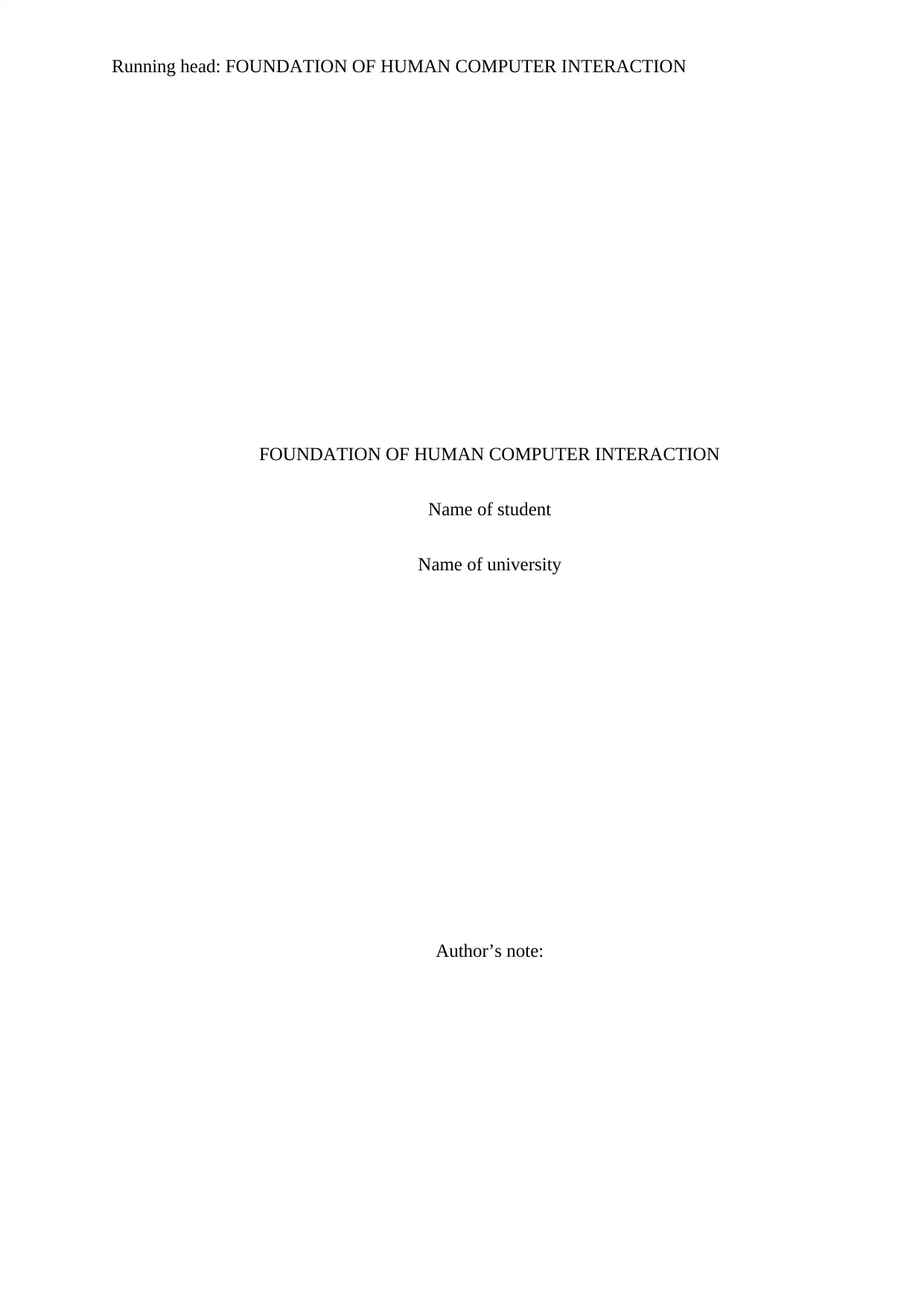
Running head: FOUNDATION OF HUMAN COMPUTER INTERACTION
FOUNDATION OF HUMAN COMPUTER INTERACTION
Name of student
Name of university
Author’s note:
FOUNDATION OF HUMAN COMPUTER INTERACTION
Name of student
Name of university
Author’s note:
Paraphrase This Document
Need a fresh take? Get an instant paraphrase of this document with our AI Paraphraser
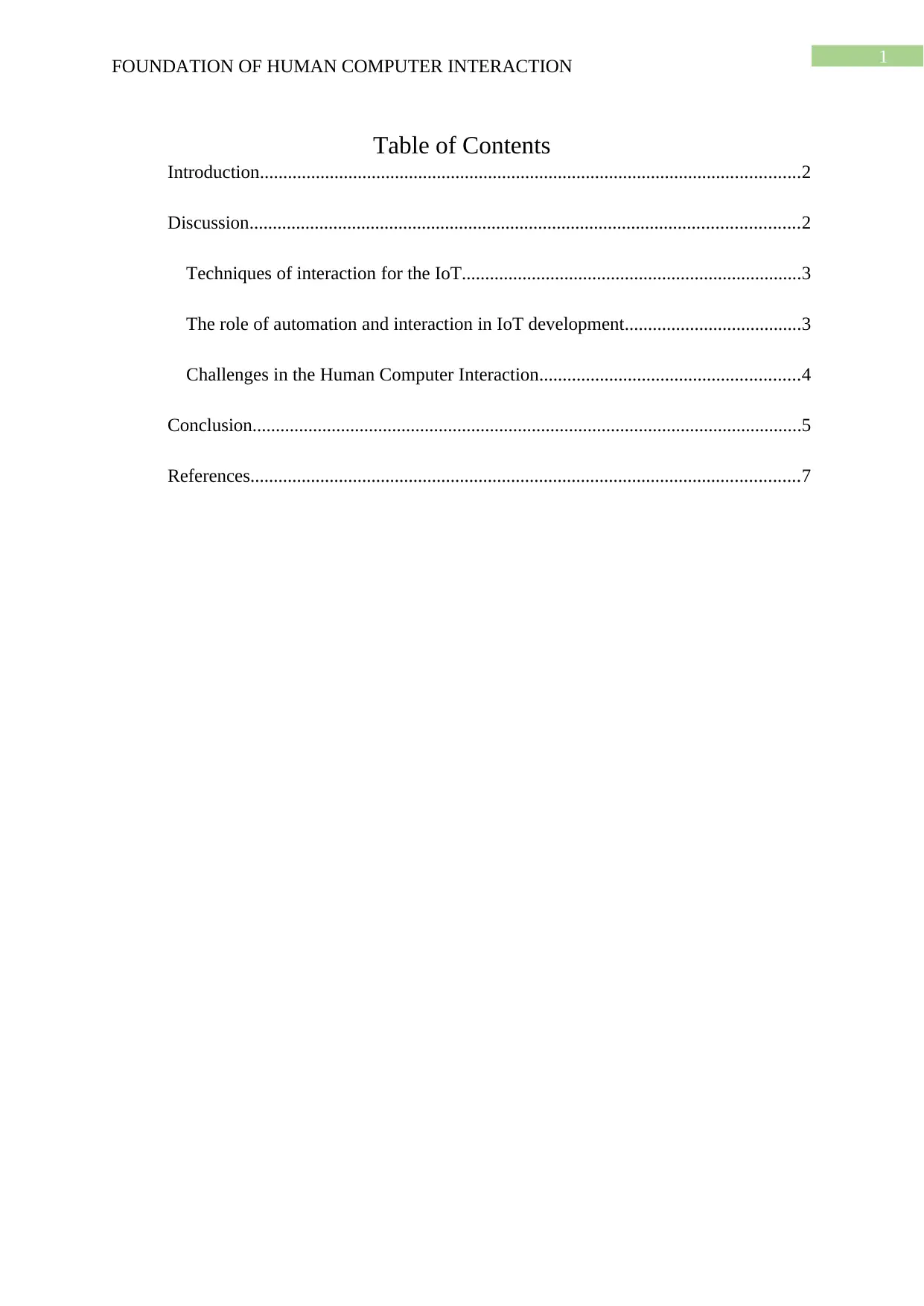
1
FOUNDATION OF HUMAN COMPUTER INTERACTION
Table of Contents
Introduction....................................................................................................................2
Discussion......................................................................................................................2
Techniques of interaction for the IoT.........................................................................3
The role of automation and interaction in IoT development......................................3
Challenges in the Human Computer Interaction........................................................4
Conclusion......................................................................................................................5
References......................................................................................................................7
FOUNDATION OF HUMAN COMPUTER INTERACTION
Table of Contents
Introduction....................................................................................................................2
Discussion......................................................................................................................2
Techniques of interaction for the IoT.........................................................................3
The role of automation and interaction in IoT development......................................3
Challenges in the Human Computer Interaction........................................................4
Conclusion......................................................................................................................5
References......................................................................................................................7
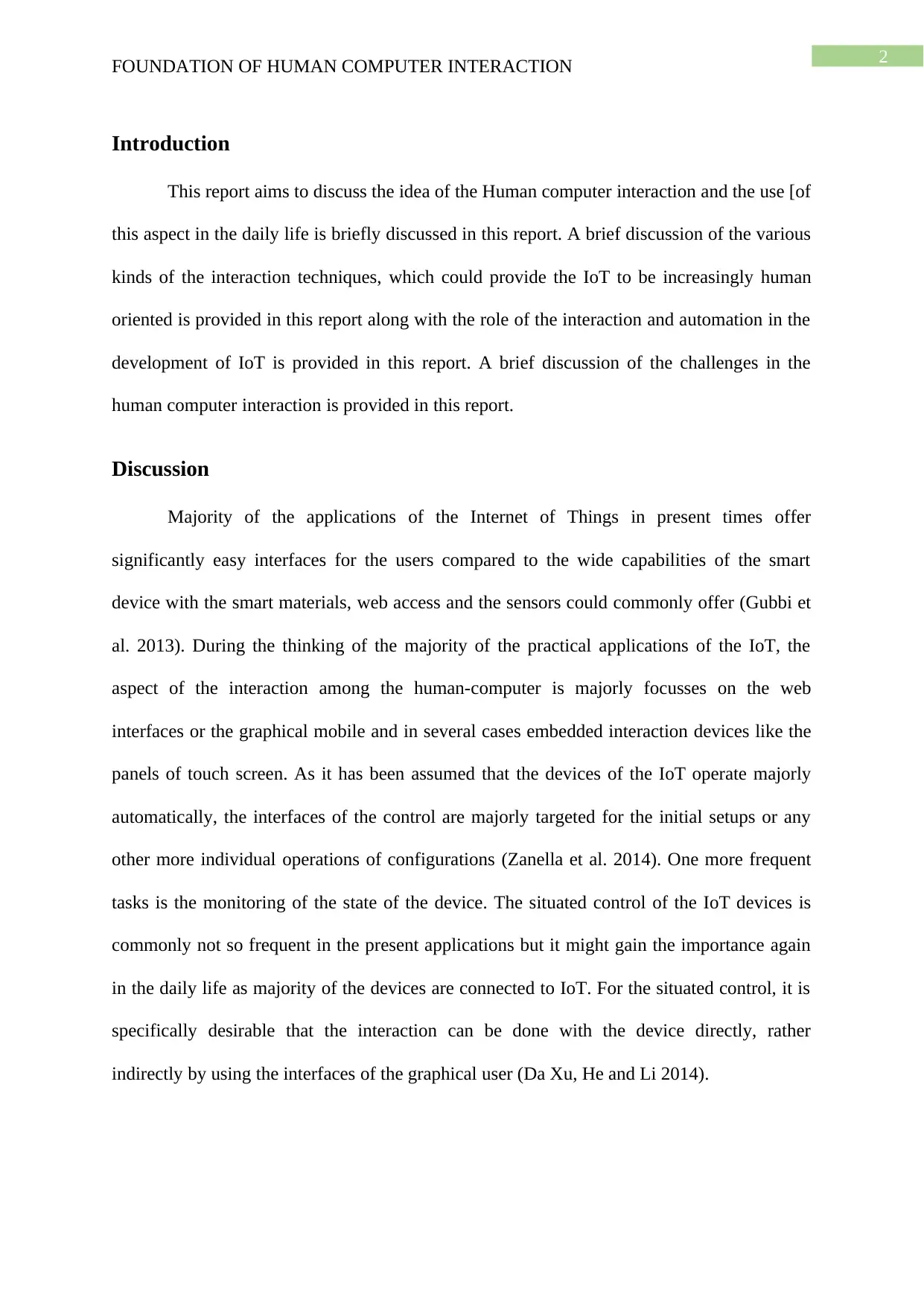
2
FOUNDATION OF HUMAN COMPUTER INTERACTION
Introduction
This report aims to discuss the idea of the Human computer interaction and the use [of
this aspect in the daily life is briefly discussed in this report. A brief discussion of the various
kinds of the interaction techniques, which could provide the IoT to be increasingly human
oriented is provided in this report along with the role of the interaction and automation in the
development of IoT is provided in this report. A brief discussion of the challenges in the
human computer interaction is provided in this report.
Discussion
Majority of the applications of the Internet of Things in present times offer
significantly easy interfaces for the users compared to the wide capabilities of the smart
device with the smart materials, web access and the sensors could commonly offer (Gubbi et
al. 2013). During the thinking of the majority of the practical applications of the IoT, the
aspect of the interaction among the human-computer is majorly focusses on the web
interfaces or the graphical mobile and in several cases embedded interaction devices like the
panels of touch screen. As it has been assumed that the devices of the IoT operate majorly
automatically, the interfaces of the control are majorly targeted for the initial setups or any
other more individual operations of configurations (Zanella et al. 2014). One more frequent
tasks is the monitoring of the state of the device. The situated control of the IoT devices is
commonly not so frequent in the present applications but it might gain the importance again
in the daily life as majority of the devices are connected to IoT. For the situated control, it is
specifically desirable that the interaction can be done with the device directly, rather
indirectly by using the interfaces of the graphical user (Da Xu, He and Li 2014).
FOUNDATION OF HUMAN COMPUTER INTERACTION
Introduction
This report aims to discuss the idea of the Human computer interaction and the use [of
this aspect in the daily life is briefly discussed in this report. A brief discussion of the various
kinds of the interaction techniques, which could provide the IoT to be increasingly human
oriented is provided in this report along with the role of the interaction and automation in the
development of IoT is provided in this report. A brief discussion of the challenges in the
human computer interaction is provided in this report.
Discussion
Majority of the applications of the Internet of Things in present times offer
significantly easy interfaces for the users compared to the wide capabilities of the smart
device with the smart materials, web access and the sensors could commonly offer (Gubbi et
al. 2013). During the thinking of the majority of the practical applications of the IoT, the
aspect of the interaction among the human-computer is majorly focusses on the web
interfaces or the graphical mobile and in several cases embedded interaction devices like the
panels of touch screen. As it has been assumed that the devices of the IoT operate majorly
automatically, the interfaces of the control are majorly targeted for the initial setups or any
other more individual operations of configurations (Zanella et al. 2014). One more frequent
tasks is the monitoring of the state of the device. The situated control of the IoT devices is
commonly not so frequent in the present applications but it might gain the importance again
in the daily life as majority of the devices are connected to IoT. For the situated control, it is
specifically desirable that the interaction can be done with the device directly, rather
indirectly by using the interfaces of the graphical user (Da Xu, He and Li 2014).
⊘ This is a preview!⊘
Do you want full access?
Subscribe today to unlock all pages.

Trusted by 1+ million students worldwide
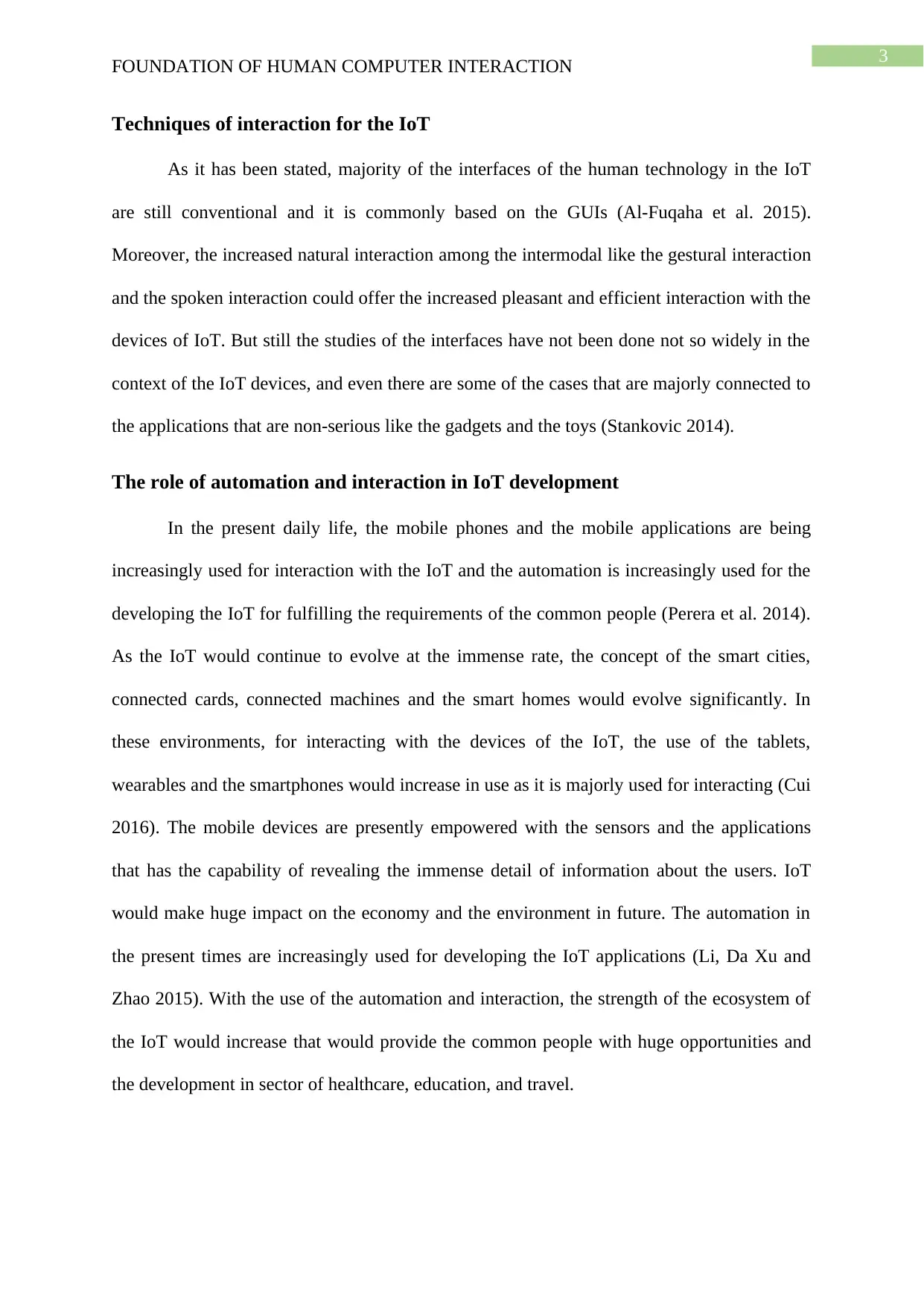
3
FOUNDATION OF HUMAN COMPUTER INTERACTION
Techniques of interaction for the IoT
As it has been stated, majority of the interfaces of the human technology in the IoT
are still conventional and it is commonly based on the GUIs (Al-Fuqaha et al. 2015).
Moreover, the increased natural interaction among the intermodal like the gestural interaction
and the spoken interaction could offer the increased pleasant and efficient interaction with the
devices of IoT. But still the studies of the interfaces have not been done not so widely in the
context of the IoT devices, and even there are some of the cases that are majorly connected to
the applications that are non-serious like the gadgets and the toys (Stankovic 2014).
The role of automation and interaction in IoT development
In the present daily life, the mobile phones and the mobile applications are being
increasingly used for interaction with the IoT and the automation is increasingly used for the
developing the IoT for fulfilling the requirements of the common people (Perera et al. 2014).
As the IoT would continue to evolve at the immense rate, the concept of the smart cities,
connected cards, connected machines and the smart homes would evolve significantly. In
these environments, for interacting with the devices of the IoT, the use of the tablets,
wearables and the smartphones would increase in use as it is majorly used for interacting (Cui
2016). The mobile devices are presently empowered with the sensors and the applications
that has the capability of revealing the immense detail of information about the users. IoT
would make huge impact on the economy and the environment in future. The automation in
the present times are increasingly used for developing the IoT applications (Li, Da Xu and
Zhao 2015). With the use of the automation and interaction, the strength of the ecosystem of
the IoT would increase that would provide the common people with huge opportunities and
the development in sector of healthcare, education, and travel.
FOUNDATION OF HUMAN COMPUTER INTERACTION
Techniques of interaction for the IoT
As it has been stated, majority of the interfaces of the human technology in the IoT
are still conventional and it is commonly based on the GUIs (Al-Fuqaha et al. 2015).
Moreover, the increased natural interaction among the intermodal like the gestural interaction
and the spoken interaction could offer the increased pleasant and efficient interaction with the
devices of IoT. But still the studies of the interfaces have not been done not so widely in the
context of the IoT devices, and even there are some of the cases that are majorly connected to
the applications that are non-serious like the gadgets and the toys (Stankovic 2014).
The role of automation and interaction in IoT development
In the present daily life, the mobile phones and the mobile applications are being
increasingly used for interaction with the IoT and the automation is increasingly used for the
developing the IoT for fulfilling the requirements of the common people (Perera et al. 2014).
As the IoT would continue to evolve at the immense rate, the concept of the smart cities,
connected cards, connected machines and the smart homes would evolve significantly. In
these environments, for interacting with the devices of the IoT, the use of the tablets,
wearables and the smartphones would increase in use as it is majorly used for interacting (Cui
2016). The mobile devices are presently empowered with the sensors and the applications
that has the capability of revealing the immense detail of information about the users. IoT
would make huge impact on the economy and the environment in future. The automation in
the present times are increasingly used for developing the IoT applications (Li, Da Xu and
Zhao 2015). With the use of the automation and interaction, the strength of the ecosystem of
the IoT would increase that would provide the common people with huge opportunities and
the development in sector of healthcare, education, and travel.
Paraphrase This Document
Need a fresh take? Get an instant paraphrase of this document with our AI Paraphraser
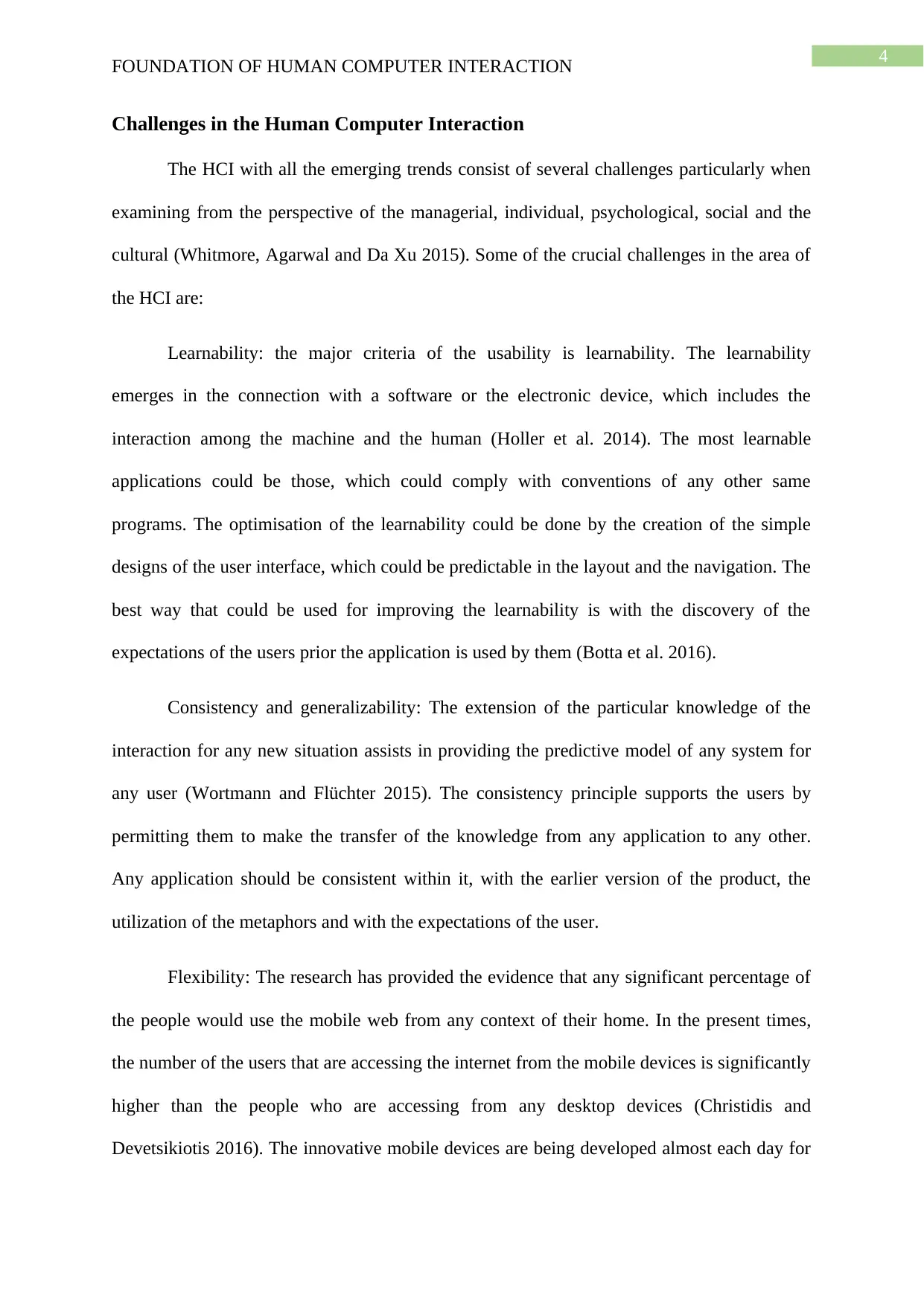
4
FOUNDATION OF HUMAN COMPUTER INTERACTION
Challenges in the Human Computer Interaction
The HCI with all the emerging trends consist of several challenges particularly when
examining from the perspective of the managerial, individual, psychological, social and the
cultural (Whitmore, Agarwal and Da Xu 2015). Some of the crucial challenges in the area of
the HCI are:
Learnability: the major criteria of the usability is learnability. The learnability
emerges in the connection with a software or the electronic device, which includes the
interaction among the machine and the human (Holler et al. 2014). The most learnable
applications could be those, which could comply with conventions of any other same
programs. The optimisation of the learnability could be done by the creation of the simple
designs of the user interface, which could be predictable in the layout and the navigation. The
best way that could be used for improving the learnability is with the discovery of the
expectations of the users prior the application is used by them (Botta et al. 2016).
Consistency and generalizability: The extension of the particular knowledge of the
interaction for any new situation assists in providing the predictive model of any system for
any user (Wortmann and Flüchter 2015). The consistency principle supports the users by
permitting them to make the transfer of the knowledge from any application to any other.
Any application should be consistent within it, with the earlier version of the product, the
utilization of the metaphors and with the expectations of the user.
Flexibility: The research has provided the evidence that any significant percentage of
the people would use the mobile web from any context of their home. In the present times,
the number of the users that are accessing the internet from the mobile devices is significantly
higher than the people who are accessing from any desktop devices (Christidis and
Devetsikiotis 2016). The innovative mobile devices are being developed almost each day for
FOUNDATION OF HUMAN COMPUTER INTERACTION
Challenges in the Human Computer Interaction
The HCI with all the emerging trends consist of several challenges particularly when
examining from the perspective of the managerial, individual, psychological, social and the
cultural (Whitmore, Agarwal and Da Xu 2015). Some of the crucial challenges in the area of
the HCI are:
Learnability: the major criteria of the usability is learnability. The learnability
emerges in the connection with a software or the electronic device, which includes the
interaction among the machine and the human (Holler et al. 2014). The most learnable
applications could be those, which could comply with conventions of any other same
programs. The optimisation of the learnability could be done by the creation of the simple
designs of the user interface, which could be predictable in the layout and the navigation. The
best way that could be used for improving the learnability is with the discovery of the
expectations of the users prior the application is used by them (Botta et al. 2016).
Consistency and generalizability: The extension of the particular knowledge of the
interaction for any new situation assists in providing the predictive model of any system for
any user (Wortmann and Flüchter 2015). The consistency principle supports the users by
permitting them to make the transfer of the knowledge from any application to any other.
Any application should be consistent within it, with the earlier version of the product, the
utilization of the metaphors and with the expectations of the user.
Flexibility: The research has provided the evidence that any significant percentage of
the people would use the mobile web from any context of their home. In the present times,
the number of the users that are accessing the internet from the mobile devices is significantly
higher than the people who are accessing from any desktop devices (Christidis and
Devetsikiotis 2016). The innovative mobile devices are being developed almost each day for
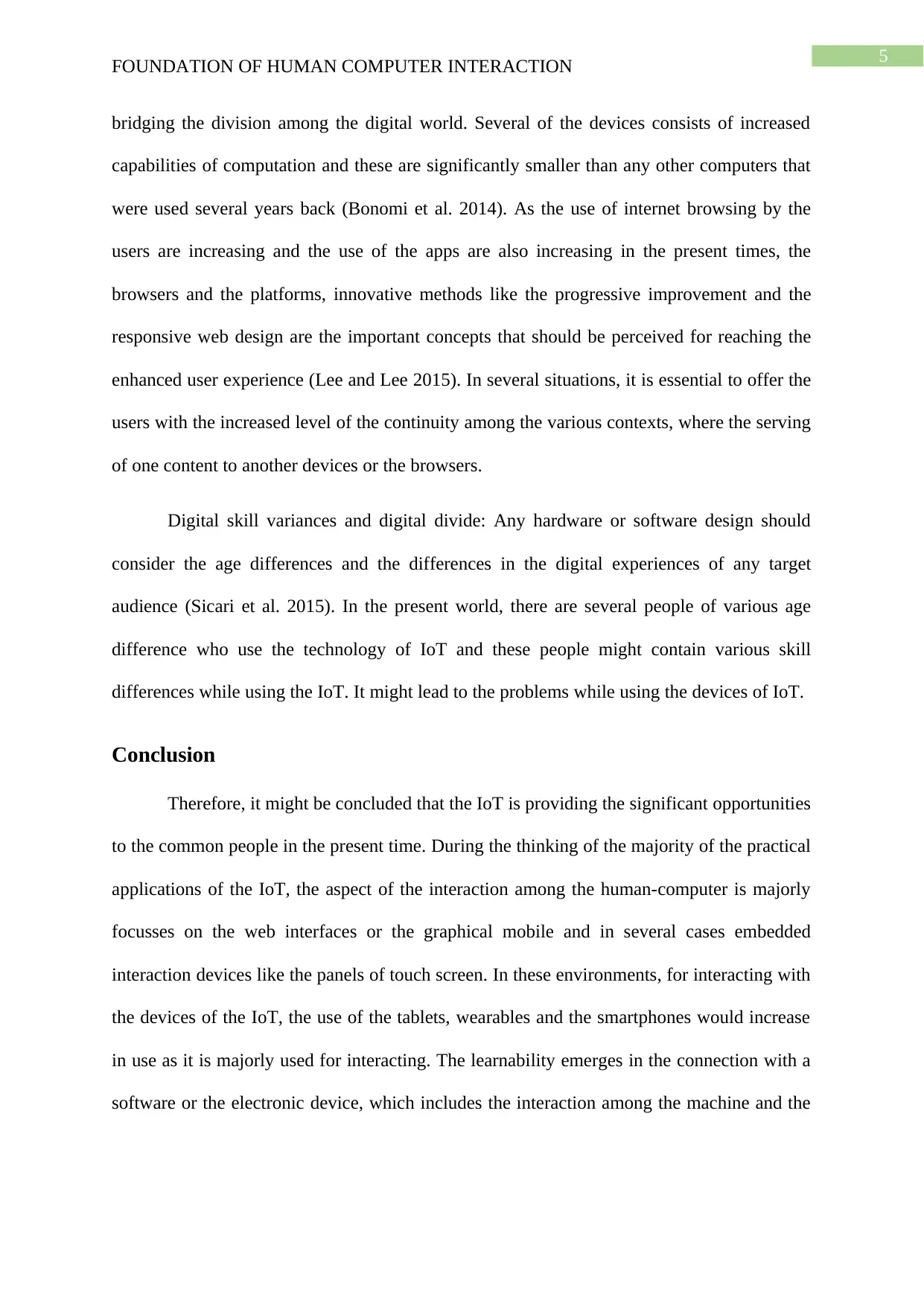
5
FOUNDATION OF HUMAN COMPUTER INTERACTION
bridging the division among the digital world. Several of the devices consists of increased
capabilities of computation and these are significantly smaller than any other computers that
were used several years back (Bonomi et al. 2014). As the use of internet browsing by the
users are increasing and the use of the apps are also increasing in the present times, the
browsers and the platforms, innovative methods like the progressive improvement and the
responsive web design are the important concepts that should be perceived for reaching the
enhanced user experience (Lee and Lee 2015). In several situations, it is essential to offer the
users with the increased level of the continuity among the various contexts, where the serving
of one content to another devices or the browsers.
Digital skill variances and digital divide: Any hardware or software design should
consider the age differences and the differences in the digital experiences of any target
audience (Sicari et al. 2015). In the present world, there are several people of various age
difference who use the technology of IoT and these people might contain various skill
differences while using the IoT. It might lead to the problems while using the devices of IoT.
Conclusion
Therefore, it might be concluded that the IoT is providing the significant opportunities
to the common people in the present time. During the thinking of the majority of the practical
applications of the IoT, the aspect of the interaction among the human-computer is majorly
focusses on the web interfaces or the graphical mobile and in several cases embedded
interaction devices like the panels of touch screen. In these environments, for interacting with
the devices of the IoT, the use of the tablets, wearables and the smartphones would increase
in use as it is majorly used for interacting. The learnability emerges in the connection with a
software or the electronic device, which includes the interaction among the machine and the
FOUNDATION OF HUMAN COMPUTER INTERACTION
bridging the division among the digital world. Several of the devices consists of increased
capabilities of computation and these are significantly smaller than any other computers that
were used several years back (Bonomi et al. 2014). As the use of internet browsing by the
users are increasing and the use of the apps are also increasing in the present times, the
browsers and the platforms, innovative methods like the progressive improvement and the
responsive web design are the important concepts that should be perceived for reaching the
enhanced user experience (Lee and Lee 2015). In several situations, it is essential to offer the
users with the increased level of the continuity among the various contexts, where the serving
of one content to another devices or the browsers.
Digital skill variances and digital divide: Any hardware or software design should
consider the age differences and the differences in the digital experiences of any target
audience (Sicari et al. 2015). In the present world, there are several people of various age
difference who use the technology of IoT and these people might contain various skill
differences while using the IoT. It might lead to the problems while using the devices of IoT.
Conclusion
Therefore, it might be concluded that the IoT is providing the significant opportunities
to the common people in the present time. During the thinking of the majority of the practical
applications of the IoT, the aspect of the interaction among the human-computer is majorly
focusses on the web interfaces or the graphical mobile and in several cases embedded
interaction devices like the panels of touch screen. In these environments, for interacting with
the devices of the IoT, the use of the tablets, wearables and the smartphones would increase
in use as it is majorly used for interacting. The learnability emerges in the connection with a
software or the electronic device, which includes the interaction among the machine and the
⊘ This is a preview!⊘
Do you want full access?
Subscribe today to unlock all pages.

Trusted by 1+ million students worldwide
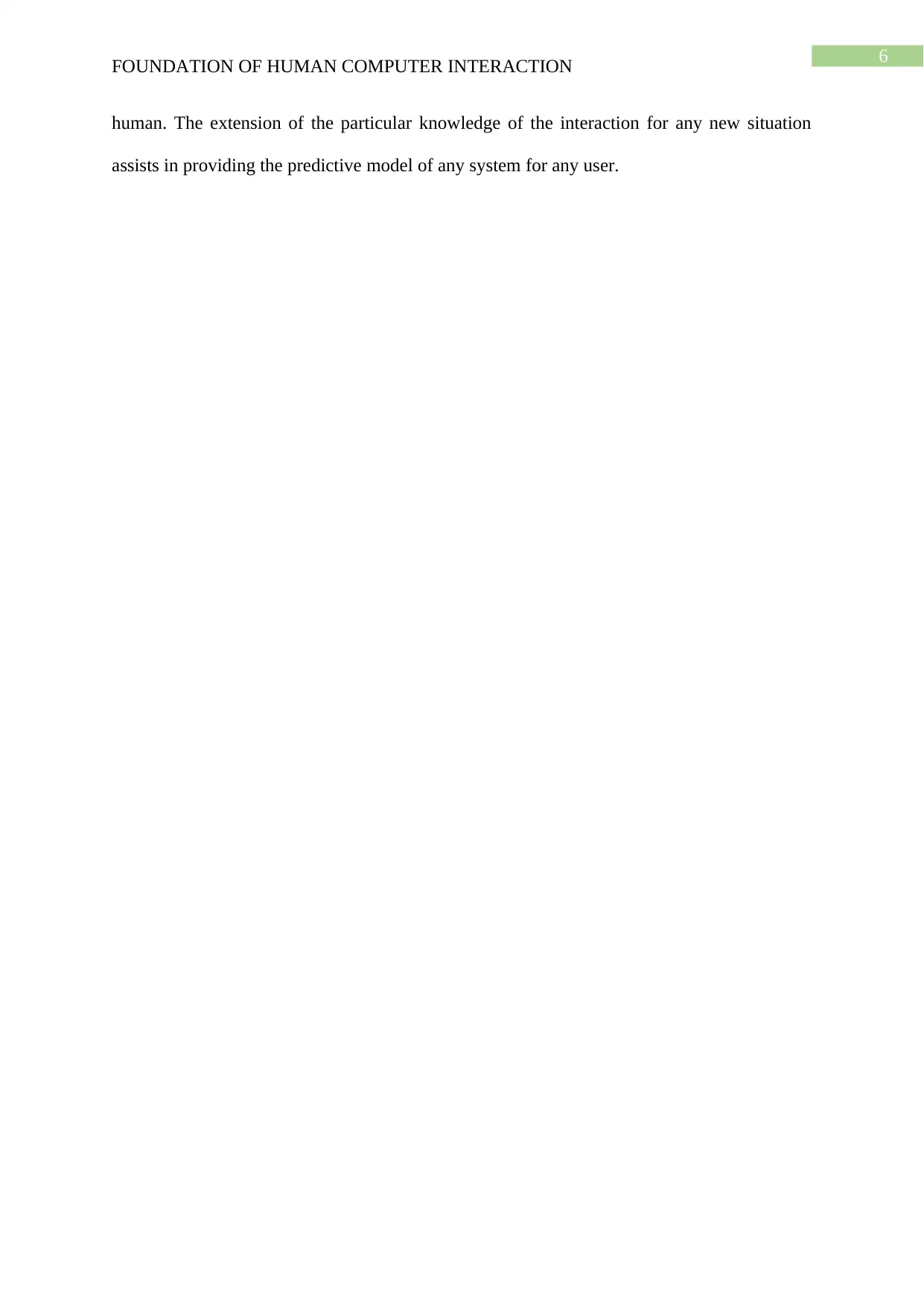
6
FOUNDATION OF HUMAN COMPUTER INTERACTION
human. The extension of the particular knowledge of the interaction for any new situation
assists in providing the predictive model of any system for any user.
FOUNDATION OF HUMAN COMPUTER INTERACTION
human. The extension of the particular knowledge of the interaction for any new situation
assists in providing the predictive model of any system for any user.
Paraphrase This Document
Need a fresh take? Get an instant paraphrase of this document with our AI Paraphraser
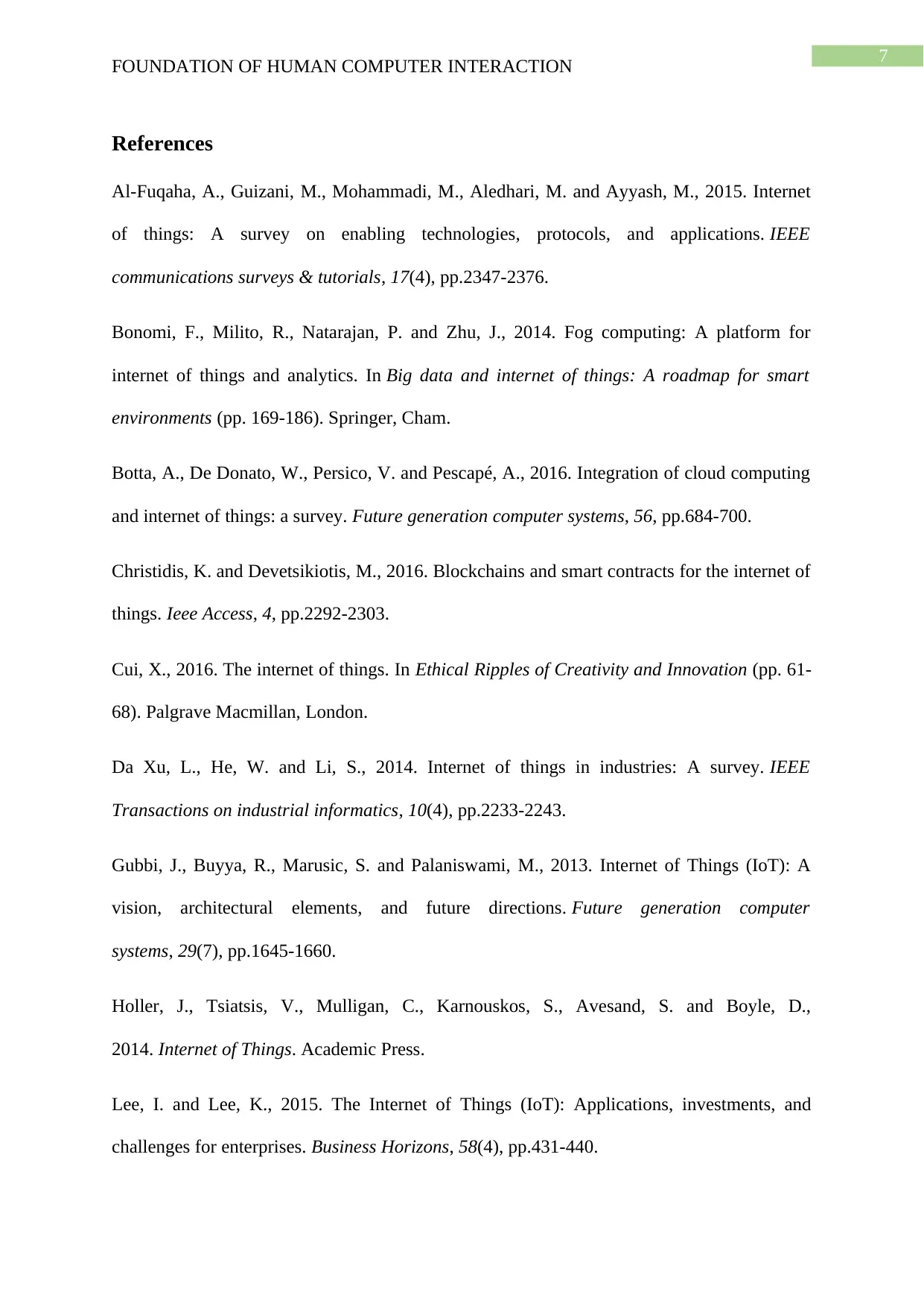
7
FOUNDATION OF HUMAN COMPUTER INTERACTION
References
Al-Fuqaha, A., Guizani, M., Mohammadi, M., Aledhari, M. and Ayyash, M., 2015. Internet
of things: A survey on enabling technologies, protocols, and applications. IEEE
communications surveys & tutorials, 17(4), pp.2347-2376.
Bonomi, F., Milito, R., Natarajan, P. and Zhu, J., 2014. Fog computing: A platform for
internet of things and analytics. In Big data and internet of things: A roadmap for smart
environments (pp. 169-186). Springer, Cham.
Botta, A., De Donato, W., Persico, V. and Pescapé, A., 2016. Integration of cloud computing
and internet of things: a survey. Future generation computer systems, 56, pp.684-700.
Christidis, K. and Devetsikiotis, M., 2016. Blockchains and smart contracts for the internet of
things. Ieee Access, 4, pp.2292-2303.
Cui, X., 2016. The internet of things. In Ethical Ripples of Creativity and Innovation (pp. 61-
68). Palgrave Macmillan, London.
Da Xu, L., He, W. and Li, S., 2014. Internet of things in industries: A survey. IEEE
Transactions on industrial informatics, 10(4), pp.2233-2243.
Gubbi, J., Buyya, R., Marusic, S. and Palaniswami, M., 2013. Internet of Things (IoT): A
vision, architectural elements, and future directions. Future generation computer
systems, 29(7), pp.1645-1660.
Holler, J., Tsiatsis, V., Mulligan, C., Karnouskos, S., Avesand, S. and Boyle, D.,
2014. Internet of Things. Academic Press.
Lee, I. and Lee, K., 2015. The Internet of Things (IoT): Applications, investments, and
challenges for enterprises. Business Horizons, 58(4), pp.431-440.
FOUNDATION OF HUMAN COMPUTER INTERACTION
References
Al-Fuqaha, A., Guizani, M., Mohammadi, M., Aledhari, M. and Ayyash, M., 2015. Internet
of things: A survey on enabling technologies, protocols, and applications. IEEE
communications surveys & tutorials, 17(4), pp.2347-2376.
Bonomi, F., Milito, R., Natarajan, P. and Zhu, J., 2014. Fog computing: A platform for
internet of things and analytics. In Big data and internet of things: A roadmap for smart
environments (pp. 169-186). Springer, Cham.
Botta, A., De Donato, W., Persico, V. and Pescapé, A., 2016. Integration of cloud computing
and internet of things: a survey. Future generation computer systems, 56, pp.684-700.
Christidis, K. and Devetsikiotis, M., 2016. Blockchains and smart contracts for the internet of
things. Ieee Access, 4, pp.2292-2303.
Cui, X., 2016. The internet of things. In Ethical Ripples of Creativity and Innovation (pp. 61-
68). Palgrave Macmillan, London.
Da Xu, L., He, W. and Li, S., 2014. Internet of things in industries: A survey. IEEE
Transactions on industrial informatics, 10(4), pp.2233-2243.
Gubbi, J., Buyya, R., Marusic, S. and Palaniswami, M., 2013. Internet of Things (IoT): A
vision, architectural elements, and future directions. Future generation computer
systems, 29(7), pp.1645-1660.
Holler, J., Tsiatsis, V., Mulligan, C., Karnouskos, S., Avesand, S. and Boyle, D.,
2014. Internet of Things. Academic Press.
Lee, I. and Lee, K., 2015. The Internet of Things (IoT): Applications, investments, and
challenges for enterprises. Business Horizons, 58(4), pp.431-440.
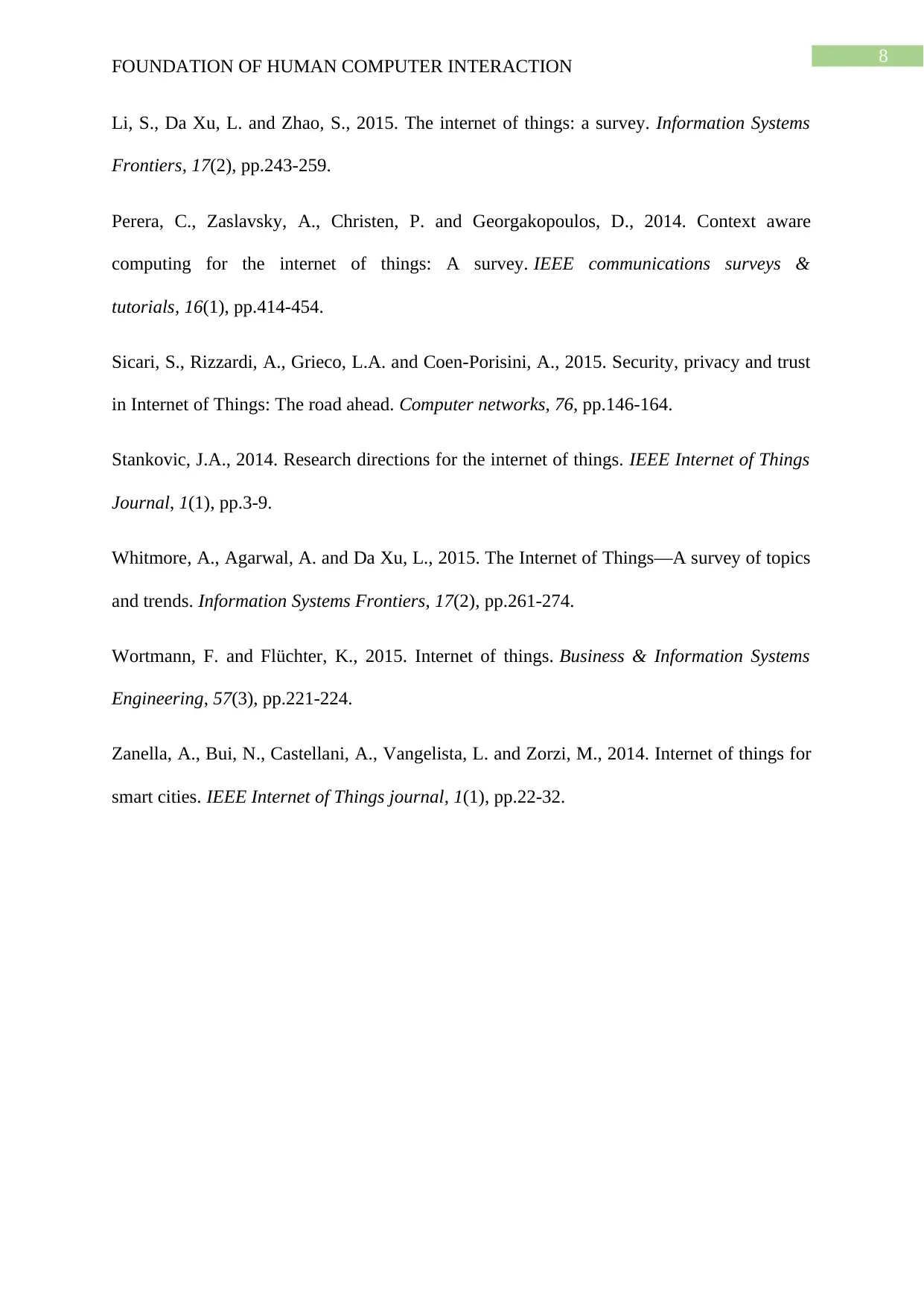
8
FOUNDATION OF HUMAN COMPUTER INTERACTION
Li, S., Da Xu, L. and Zhao, S., 2015. The internet of things: a survey. Information Systems
Frontiers, 17(2), pp.243-259.
Perera, C., Zaslavsky, A., Christen, P. and Georgakopoulos, D., 2014. Context aware
computing for the internet of things: A survey. IEEE communications surveys &
tutorials, 16(1), pp.414-454.
Sicari, S., Rizzardi, A., Grieco, L.A. and Coen-Porisini, A., 2015. Security, privacy and trust
in Internet of Things: The road ahead. Computer networks, 76, pp.146-164.
Stankovic, J.A., 2014. Research directions for the internet of things. IEEE Internet of Things
Journal, 1(1), pp.3-9.
Whitmore, A., Agarwal, A. and Da Xu, L., 2015. The Internet of Things—A survey of topics
and trends. Information Systems Frontiers, 17(2), pp.261-274.
Wortmann, F. and Flüchter, K., 2015. Internet of things. Business & Information Systems
Engineering, 57(3), pp.221-224.
Zanella, A., Bui, N., Castellani, A., Vangelista, L. and Zorzi, M., 2014. Internet of things for
smart cities. IEEE Internet of Things journal, 1(1), pp.22-32.
FOUNDATION OF HUMAN COMPUTER INTERACTION
Li, S., Da Xu, L. and Zhao, S., 2015. The internet of things: a survey. Information Systems
Frontiers, 17(2), pp.243-259.
Perera, C., Zaslavsky, A., Christen, P. and Georgakopoulos, D., 2014. Context aware
computing for the internet of things: A survey. IEEE communications surveys &
tutorials, 16(1), pp.414-454.
Sicari, S., Rizzardi, A., Grieco, L.A. and Coen-Porisini, A., 2015. Security, privacy and trust
in Internet of Things: The road ahead. Computer networks, 76, pp.146-164.
Stankovic, J.A., 2014. Research directions for the internet of things. IEEE Internet of Things
Journal, 1(1), pp.3-9.
Whitmore, A., Agarwal, A. and Da Xu, L., 2015. The Internet of Things—A survey of topics
and trends. Information Systems Frontiers, 17(2), pp.261-274.
Wortmann, F. and Flüchter, K., 2015. Internet of things. Business & Information Systems
Engineering, 57(3), pp.221-224.
Zanella, A., Bui, N., Castellani, A., Vangelista, L. and Zorzi, M., 2014. Internet of things for
smart cities. IEEE Internet of Things journal, 1(1), pp.22-32.
⊘ This is a preview!⊘
Do you want full access?
Subscribe today to unlock all pages.

Trusted by 1+ million students worldwide
1 out of 9
Related Documents
Your All-in-One AI-Powered Toolkit for Academic Success.
+13062052269
info@desklib.com
Available 24*7 on WhatsApp / Email
![[object Object]](/_next/static/media/star-bottom.7253800d.svg)
Unlock your academic potential
Copyright © 2020–2025 A2Z Services. All Rights Reserved. Developed and managed by ZUCOL.




